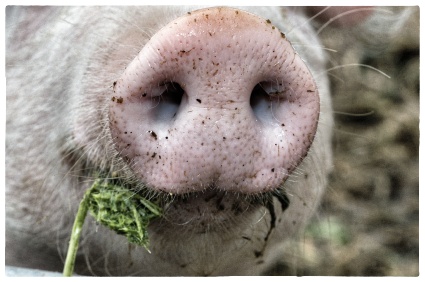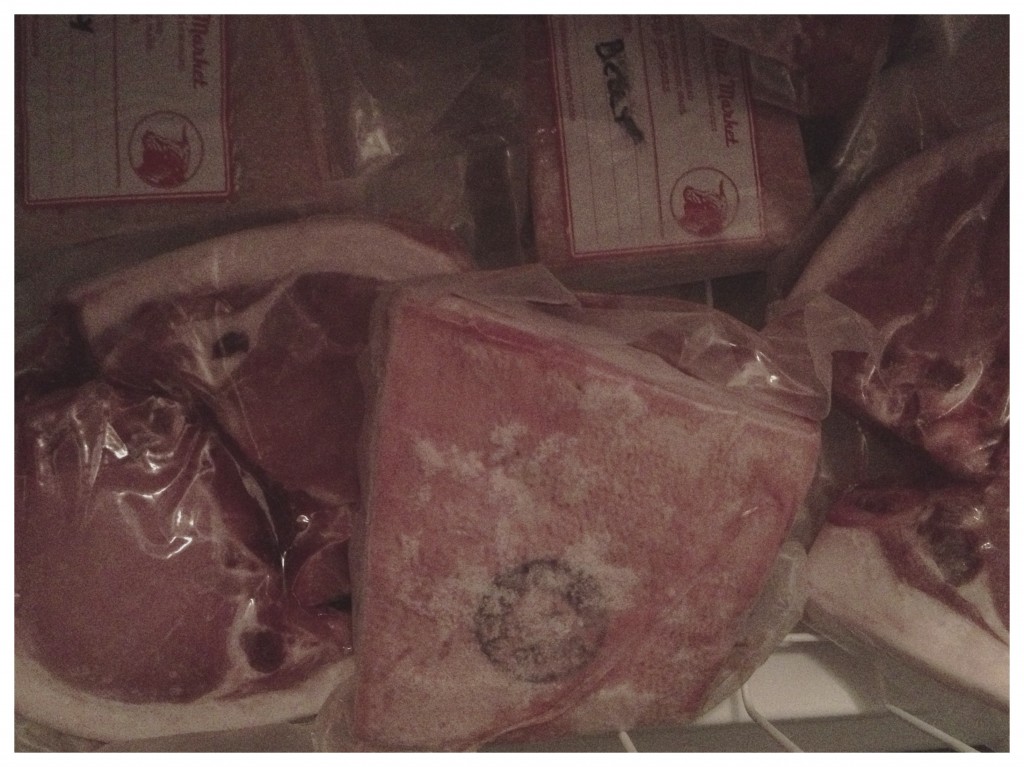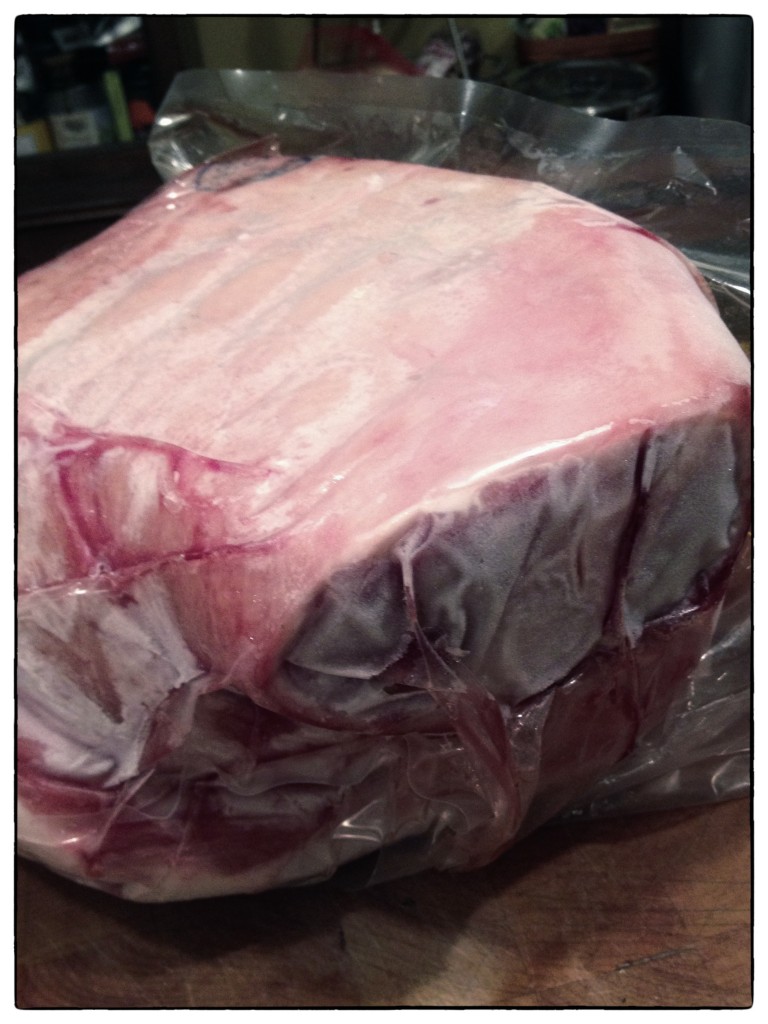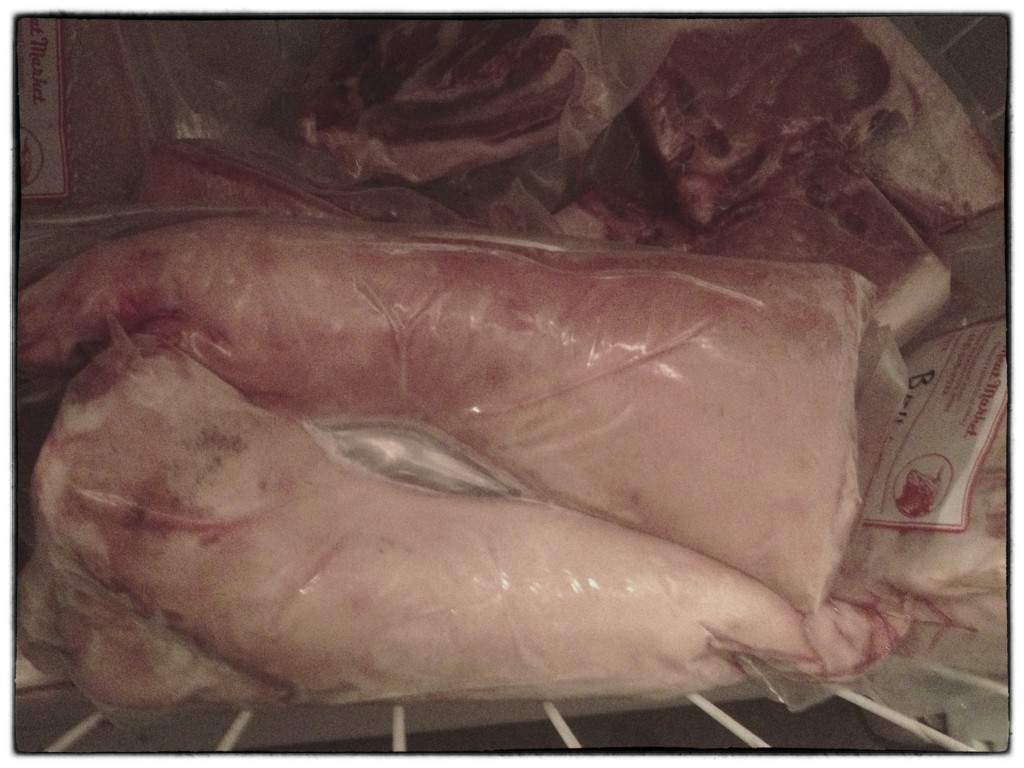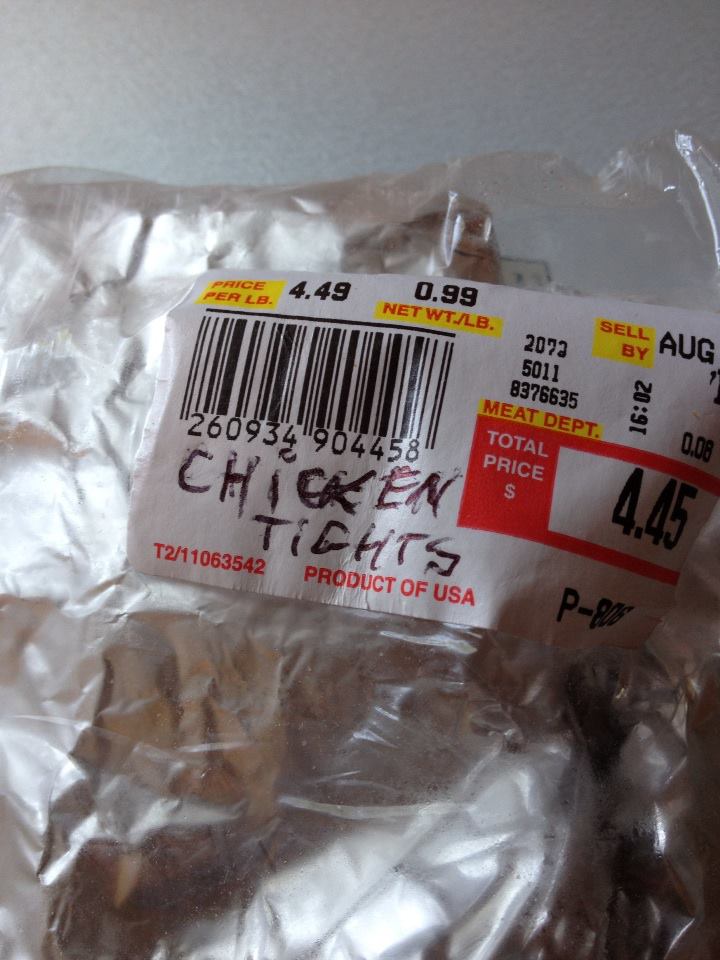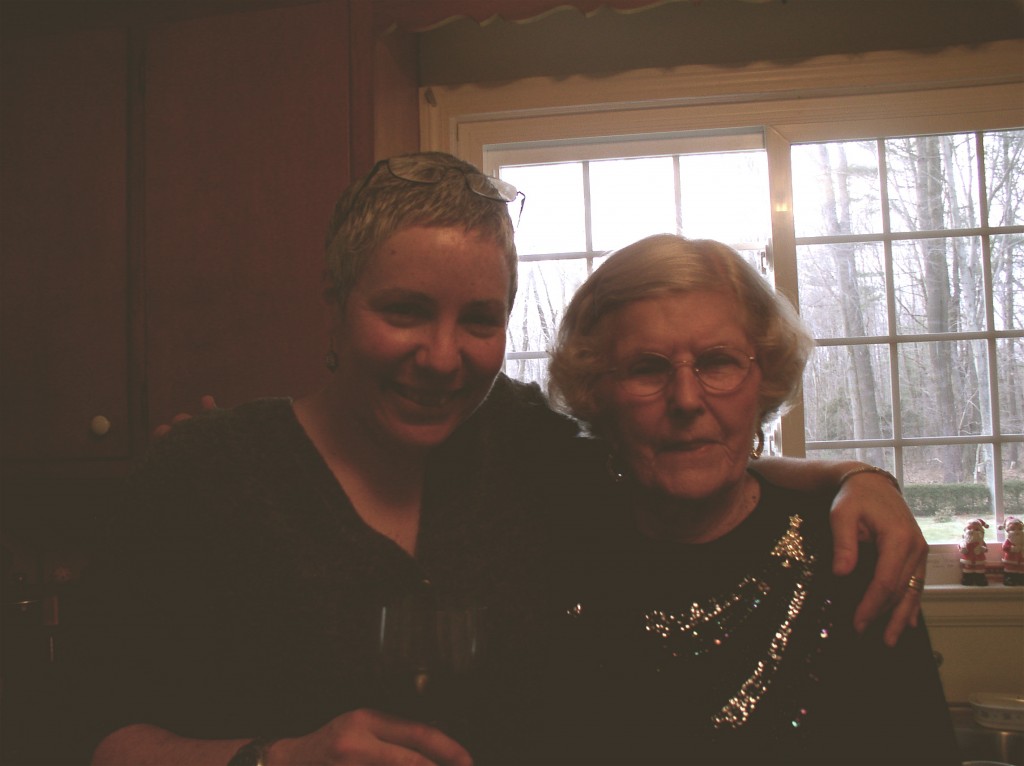Pardon my French: I have to get this off my chest. Hide the children. Vegetarians, look away.
I have a f**king pig in my downstairs freezer.
I had to buy the downstairs freezer specifically for my f**king pig. Together, they cost me $1325: $700 for the f**king pig, and $625 for the f**king freezer.
The pig arrived last Fall, as pigs usually do; food writer friends of mine — terrific, hardcore food people of the type who are always writing massive cookbooks, and are forever in the throes of recipe creation and testing and throwing spectacular dinner parties — suggested we go in on it, and it seemed like a gosh darn swell idea at the time, since I’m always flapping my gums about the fact that I refuse on principal to eat industrially-produced meat. So we agreed to have the animal raised by a western Massachusetts farmer and on a cool day last October, after the pig was dispatched at a local slaughterhouse and then butchered by a local high-end butcher, I drove up to my friends’ house in the Berkshires with every cooler I own stuffed into the back of my car; the guys helped me pack up my half of the cryovacked cuts, and I drove home.
Just me and my f**king pig.
I backed the car in to my driveway so that it’d be easier for me to get the pig — all 150 pounds of it— through the garage and into the basement, where the freezer stands, between an electricity-sucking wine cooler that is usually empty (don’t read into that) and a second, enormous refrigerator that we bought as a back-up for when we have Thanksgiving or Christmas or Easter or Passover at our house, which of course we almost never do. It took me forty-five minutes to lug all of the meat into the basement and another twenty to figure out how to organize it, even though I’m not a Virgo.
There was at least twenty pounds of pork belly, divided up into three pound, square, brick-like packages. There were more chops than I’ve ever seen in one place this side of Costco. There were four trotters and ten pounds of leaf lard, fifteen pounds of pork liver, a twenty-five pound fresh ham, a mammoth Boston butt, two huge shoulders, a ten pound loin roast, four small packages of sirloin, a single rack of ribs, 5 two-pound packages of ground pork, a jowl, one kidney, and an ear. That was nearly a year ago.
If you look in my freezer now, you’ll still find the trotters, the leaf lard, the liver, most of the belly, the ham, the jowl, the Boston butt, the loin roast, the kidney, and the ear. Which is a lot of f**king pig. Which made the idea of bringing 150 pounds of meat into a house inhabited by two vegetable-loving humans a stupid f**king idea, and one that I’ll never, ever do again. Even if it is all the rage. Even if it makes me feel just the tiniest bit superior. Even if the f**king pig was a Gloucestershire Old Spot named Hector. Even if it means never having to buy pork at the supermarket again, and never again shelling out my hard earned cash for meat from an animal that lived a short, tortured existence.
The bottom line: for me, having a pig raised and slaughtered for my consumption was an exercise in frippery and excess. And unless you live in a rural area, you have dinner parties every single weekend, or The King Family is living under your roof, it’s a frivolous, short-sighted idea for you too. On the one hand, you might have a day job, a commute, a wife, two dogs, maybe a few kids, a house to look after, an aging mother, an aging mother-in-law, deadlines out the wazoo, and therefore you’re totally delusional if you really think you’re going to take the time to cure your own guanciale from the jowl of your own pig. (You might have noticed: all those nice folks out in Seattle and Portland and the Bay Area and Brooklyn who do this stuff on a regular basis and do it really well, like Paul Bertolli and Armandino Batali — this is their life’s work, in most cases.) But beyond that — unless you own a restaurant or are feeding an army or have shot your own deer or live in the wiles of the great north (or south) and you otherwise have limited access to high quality fresh meat — having a whole animal (or in my case, part of an animal) in a freezer in your basement is dumb, in ways that it took me a while to figure out.
The day I took possession of my partial porker was the day I effectively stopped being a member of my local food community.
It was the day I stopped visiting my butcher on the other side of town for my weekly constitutional: a stroll around his shop, small-talk with the wonderful guys who work for him, a conversation with my butcher himself about the contents of his case —- he might have just broken down a pig or two the day before and, if a restaurant hadn’t gotten there first, there might be fresh shanks; a tail (or two); a ten pound shoulder he’d be happy to cut in half, bone out, and roll; a porchetta laden with fennel pollen; maybe three different kinds of fresh sausages. Depending on the season, the weather, and day of the week, I’d be standing there and pondering dinner: if time was short, I might take home a small boneless loin roast or a tenderloin. It it was the weekend and the temperature had dipped, I’d buy a smallish hunk of butt, for a braise. If I had a yen for Latin food, I’d come home with a sturdy shoulder meant for Cochinita Pibil which I’d wrap in banana leaves and cook for hours until the dogs drooled so badly they looked like they’d swallowed shoelaces.
And while my butcher and his guys wrapped up my purchases — which always included a hunk of house-smoked bacon and a hockey puck of pancetta — they’d want to know: So how’s your family? Did you get to the farmer’s market this week? Do you want to try some crazy-ass Hungarian-style sausage we’re just working the kinks out of? If you want to meet the farmer who raised the pork you’re taking home today, turn around and say hello. What are you cooking lately? Last December, when my town experienced the unthinkable, my butcher shop became the unofficial rest stop for those of us who, in the middle of running errands found ourselves suddenly gasping, and couldn’t put one foot in front of the other: we cared for each other, and for our butcher too, whose wife — a Sandy Hook teacher — survived the school shootings. We’re friends; we’ve shared books and recipes and laughter and tears and stories about family and tragedy and peace and travel, and always, food and sustenance. It goes without saying that I want to support him because he’s a super guy; but he’s also the proprietor of a local, independent business at the physical and personal center of my community, and he provides my town with a service that cannot be quantified. I don’t get that when I head downstairs, sad and alone, to my f**king freezer to sift through the cryovacked cuts, wondering when will be the right time for me to cure the gigantic fresh ham that’s been living there for nearly a year. Not to mention the f**king kidney, the jowl, the ear, or the trotters that now look like two pairs of porcine Jimmy Choos that got caught in an ice storm.
Whoever you are reading this, I beg you to look around, and get to know your food community before you a commit to a purchase like my aforementioned pig: are there farmer’s markets for you to frequent, where you can buy fresh or frozen local meats directly from the farmers or ranchers? Are there butchers and specialty shops for you to visit, and people in your town who have devoted their lives to producing food — growing it, raising it, harvesting it, selling it— who will benefit from your business and from the ongoing relationship you will develop with them? My guess is yes, and this is a good sight more important than the flip insouciance of vogue.
So, sure: it was a nice, feel-good, fancy pants idea to bring home half a pig, raised just for me and my friends. But if you’re not a recipe developer or a tester (I do both, but infrequently) or you’re not feeding a cast of thousands on a regular basis, or you otherwise have no access to good quality meat, it’s a better idea to pour the money back into your food community, and support your local butchers and food craftspeople who do what they do because it’s a job they love but also a skill and a talent that you are damned lucky to have access to; it’s a better idea to support purveyors at farmer’s markets, and all the specialty shops who have relationships to the farmers who raise the animals that fancy-ass boneheads like me decide, on a whim, it’d be cool to have living in my basement for a year, covered in a thin, blue rime of frostbite.
